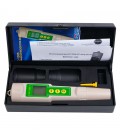Categories
- » Accessories
- » Cloning & Propagation
- » Controllers
- » Ducts, Pipes, Clamps
- » Fans
- » Filters
- » Grow Media
- » Grow Systems
- » FloraFlex
- » Indicators & Monitors
- » Method Seven
- » Lighting
- » Nutrients & Pest Control
- » Pots & Trays
- » Pumps
- » Tents, Plastics & Foils
- » All Products
- » Seeds & Clones
- » Black Friday


EC, TDS, CF, Meter 1385
EC, CF and TDS are standards used across the world for determining the nutrient content in the nutrient solution. They all provide the same info but are interpreted in different units.
MEASURING RANGE:
EC: 0.00 – 19.99uS.
CF: 0.00 – 199CF.
TDS: 10 – 19990ppm.
RESOLUTION:
EC: 0.01uS.
CF: 0.1CF.
TDS: 10ppm.
FEATURES:
Accuracy: +/- 2% F.S.
Operating Temp: 0°C - 50°C.
Batteries: 4 x 1.5 V (A G13).
Dimensions: 185mm x 38mm x 38mm.
Weight: 98g.
LCD display.
INCLUDED:
Carry case.
Calibration screwdriver.
Operating instructions.
EC, TDS and CF in hydroponics:
EC is an indication of how much resistance is in the solution. The more nutrients in the solution, the higher the EC. EC is often converted into PPM (parts per million), which is only an indication of TDS. CF is simply the European standard of measurement. An EC measurement is simply multiplied by 10 to reach the same CF. However, because the standards differ slightly, they use different conversion factors to reach TDS. For ease of use as well as accuracy, PPM is commonly used in hydroponic cultivation, however, it is an EC parameter that has been multiplied by a conversion factor. Usually, the EC meter will do the conversion automatically, however, some meters may only show EC. You then need to find out which conversion factor applies to that meter and apply it.
Plants require increasing amounts of nutrients as they grow, but will decay if the solution is too strong. It is always recommended to monitor the plant for signs of nutrient deficiency or nutrient burn and adjust the feeds accordingly.
Facts about EC/TDS meters:
The product has been factory-calibrated and usually does not have to be calibrated again, but if your value is way off, confirm with a 1000ppm (TDS) calibration fluid that the unit is reading correctly.
If you suspect the reading is wrong, clean the probe and check the batteries.
Ensure you calibrate your meter frequently using a pH calibration solution.
Keep the probe moist and clean. If you see a residue build-up on the probe, clean gently with a soft toothbrush and vinegar.
The probe is delicate! Avoid dropping or damaging the glass probe.
Accessories
Customers who bought this product also bought:
Customer ratings and reviews






















